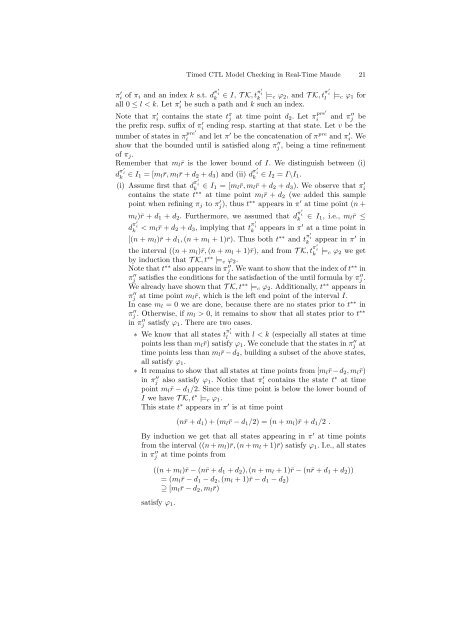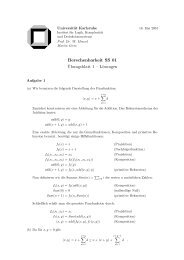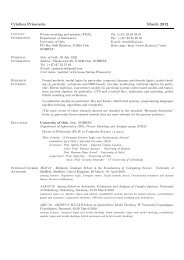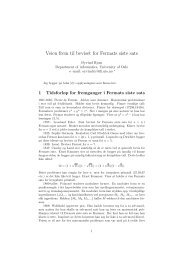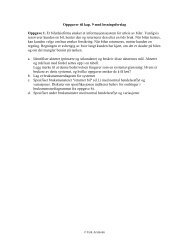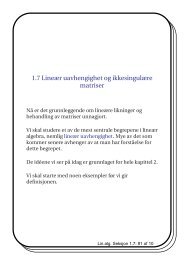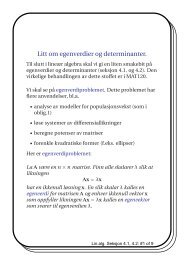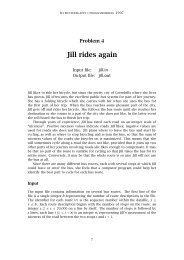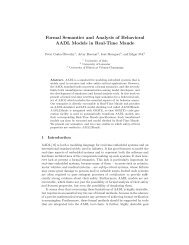Timed CTL Model Checking in Real-Time Maude⋆ - IfI
Timed CTL Model Checking in Real-Time Maude⋆ - IfI
Timed CTL Model Checking in Real-Time Maude⋆ - IfI
You also want an ePaper? Increase the reach of your titles
YUMPU automatically turns print PDFs into web optimized ePapers that Google loves.
<strong><strong>Time</strong>d</strong> <strong>CTL</strong> <strong>Model</strong> <strong>Check<strong>in</strong>g</strong> <strong>in</strong> <strong>Real</strong>-<strong>Time</strong> Maude 21<br />
π ′ i of πi and an <strong>in</strong>dex k s.t. d π′<br />
i<br />
i<br />
k ∈ I, T K, tπ′<br />
k |=c ϕ2, and T K, t π′ i<br />
l |=c ϕ1 for<br />
all 0 ≤ l < k. Let π ′ i be such a path and k such an <strong>in</strong>dex.<br />
Note that π ′ i conta<strong>in</strong>s the state tπj at time po<strong>in</strong>t d2. Let π pre′<br />
i and π ′′<br />
j be<br />
the prefix resp. suffix of π ′ i end<strong>in</strong>g resp. start<strong>in</strong>g at that state. Let v be the<br />
number of states <strong>in</strong> π pre′<br />
i and let π ′ be the concatenation of πpre and π ′ i . We<br />
show that the bounded until is satisfied along π ′′<br />
j , be<strong>in</strong>g a time ref<strong>in</strong>ement<br />
of πj.<br />
Remember that ml¯r is the lower bound of I. We dist<strong>in</strong>guish between (i)<br />
d π′<br />
i<br />
k ∈ I1 = [ml¯r, ml¯r + d2 + d3) and (ii) d π′<br />
i<br />
k ∈ I2 = I\I1.<br />
(i) Assume first that d π′ i<br />
k ∈ I1 = [ml¯r, ml¯r + d2 + d3). We observe that π ′ i<br />
conta<strong>in</strong>s the state t∗∗ at time po<strong>in</strong>t ml¯r + d2 (we added this sample<br />
po<strong>in</strong>t when ref<strong>in</strong><strong>in</strong>g πj to π ′ j ), thus t∗∗ appears <strong>in</strong> π ′ at time po<strong>in</strong>t (n +<br />
ml)¯r + d1 + d2. Furthermore, we assumed that d π′<br />
i<br />
k ∈ I1, i.e., ml¯r ≤<br />
d π′<br />
i<br />
k < ml¯r + d2 + d3, imply<strong>in</strong>g that t π′ i<br />
[(n + ml)¯r + d1, (n + ml + 1)¯r). Thus both t∗∗ and t π′ i<br />
k appear <strong>in</strong> π′ <strong>in</strong><br />
the <strong>in</strong>terval ((n + ml)¯r, (n + ml + 1)¯r), and from T K, t π′<br />
i<br />
k |=c ϕ2 we get<br />
by <strong>in</strong>duction that T K, t∗∗ |=c ϕ2.<br />
k appears <strong>in</strong> π′ at a time po<strong>in</strong>t <strong>in</strong><br />
Note that t ∗∗ also appears <strong>in</strong> π ′′<br />
j . We want to show that the <strong>in</strong>dex of t∗∗ <strong>in</strong><br />
π ′′<br />
j<br />
satisfies the conditions for the satisfaction of the until formula by π′′<br />
j .<br />
We already have shown that T K, t ∗∗ |=c ϕ2. Additionally, t ∗∗ appears <strong>in</strong><br />
π ′′<br />
j at time po<strong>in</strong>t ml¯r, which is the left end po<strong>in</strong>t of the <strong>in</strong>terval I.<br />
In case ml = 0 we are done, because there are no states prior to t∗∗ <strong>in</strong><br />
π ′′<br />
j . Otherwise, if ml > 0, it rema<strong>in</strong>s to show that all states prior to t∗∗ <strong>in</strong> π ′′<br />
j satisfy ϕ1. There are two cases.<br />
∗ We know that all states t π′<br />
i<br />
l<br />
with l < k (especially all states at time<br />
po<strong>in</strong>ts less than ml¯r) satisfy ϕ1. We conclude that the states <strong>in</strong> π ′′<br />
j at<br />
time po<strong>in</strong>ts less than ml¯r − d2, build<strong>in</strong>g a subset of the above states,<br />
all satisfy ϕ1.<br />
∗ It rema<strong>in</strong>s to show that all states at time po<strong>in</strong>ts from [ml¯r −d2, ml¯r)<br />
<strong>in</strong> π ′′<br />
j also satisfy ϕ1. Notice that π ′ i conta<strong>in</strong>s the state t∗ at time<br />
po<strong>in</strong>t ml¯r − d1/2. S<strong>in</strong>ce this time po<strong>in</strong>t is below the lower bound of<br />
I we have T K, t ∗ |=c ϕ1.<br />
This state t ∗ appears <strong>in</strong> π ′ is at time po<strong>in</strong>t<br />
(n¯r + d1) + (ml¯r − d1/2) = (n + ml)¯r + d1/2 .<br />
By <strong>in</strong>duction we get that all states appear<strong>in</strong>g <strong>in</strong> π ′ at time po<strong>in</strong>ts<br />
from the <strong>in</strong>terval ((n + ml)¯r, (n + ml + 1)¯r) satisfy ϕ1. I.e., all states<br />
<strong>in</strong> π ′′<br />
j at time po<strong>in</strong>ts from<br />
((n + ml)¯r − (n¯r + d1 + d2), (n + ml + 1)¯r − (n¯r + d1 + d2))<br />
= (ml¯r − d1 − d2, (ml + 1)¯r − d1 − d2)<br />
⊇ [ml¯r − d2, ml¯r)<br />
satisfy ϕ1.


